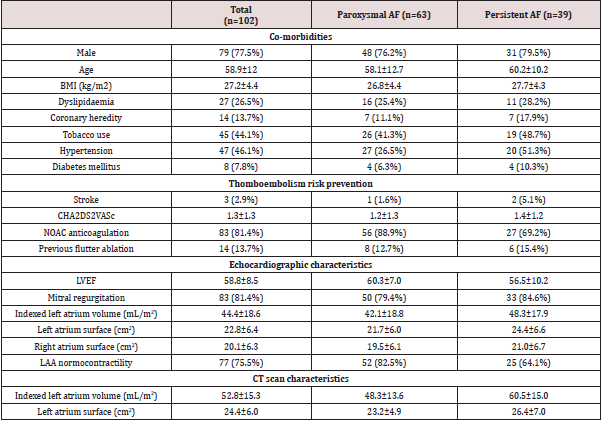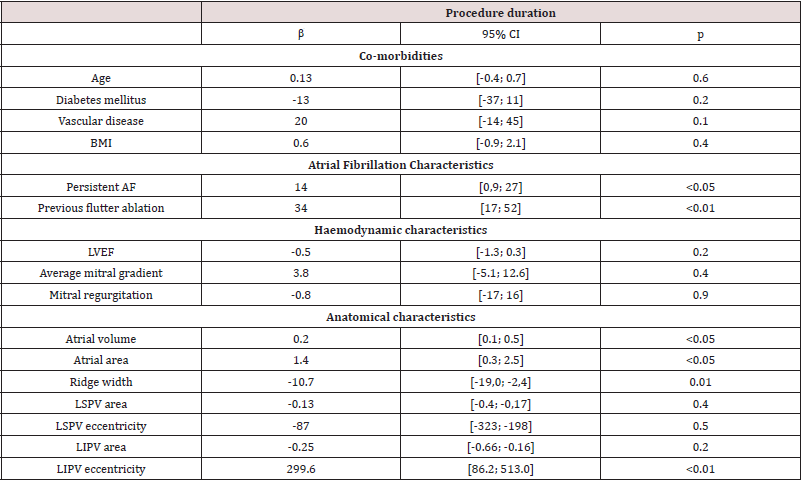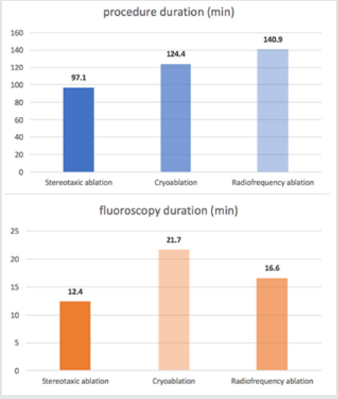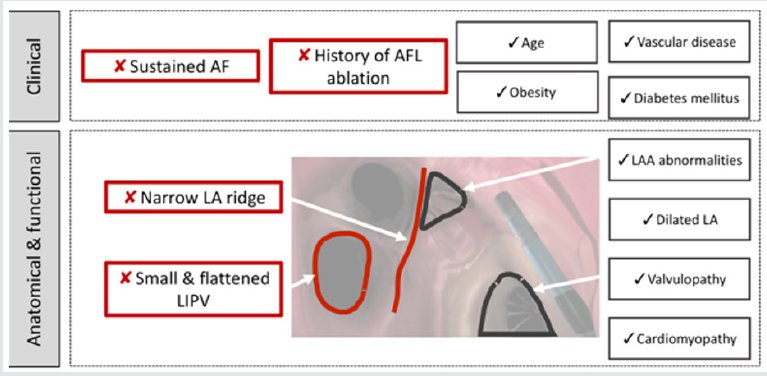Lupine Publishers | Journal of Advancements in Cardiology Research & Reports

Abstract
Background – Catheter ablation of atrial fibrillation (AF) is performed to restore and maintain a sinus rhythm. Remote magnetic navigation system (RMNS) allows an efficient and safe procedure. Left atrial (LA) anatomic barriers of this device are not well known. Aims – This study was aimed to evaluate clinical, echocardiographic and cardiac computed tomography (CCT) anatomic LA characteristics as predictors of stereotaxic AF procedure duration. Methods – From February 2015 to April 2016, 102 symptomatic and drug refractory AF patients were consecutively enrolled in an observational, prospective trial when first AF ablation. AF Radiofrequency (RF) was performed with a RMNS using Niobe ES. Clinical endpoints and LA characteristics were reported, prospectively by a transthoracic and transesophageal echocardiography, and CCT scan. Results – Mean patient age was 5912 years old, 77% male, mean CHA2DS2VASc of 1.31.3 and mean LA surface of 236.5cm2. Procedure duration of 97.232.9 minutes and fluoroscopy duration of 13.47.9 minutes were recorded. Persistent versus paroxysmal AF (p<0.05), previous flutter ablation (p<0.01), LA dilation (p<0.05), narrow LA ridge (p=0.01), small surface area and high eccentricity of the left inferior pulmonary vein (LIPV) (p<0.01) are correlated to an increased procedure duration. Previous flutter ablation (p<0.01), persistent AF (p<0.05), LIPV eccentricity (p<0.05) and ridge width (p=0.05) were found to be independently associated with procedure duration. Conclusion – Our study is the first analyzing predictors of stereotaxic procedure duration. Narrow LA ridge, small and flattened LIPV were independently correlated with an increased procedure duration. Yet neither co-morbidity nor cardiomyopathy was associated to procedure changes.
Keywords: Atrial fibrillation ablation; pulmonary vein isolation; remote magnetic navigation; procedure duration; anatomic characteristics
Introduction
Radiofrequency ablation (RF) is a treatment of choice for atrial
fibrillation (AF) because of a positive risk/benefit ratio compared
to antiarrhythmic drugs [1-3].
Even if significant advances have been made over the past
years regarding RF, pulmonary vein isolation (PVI) notably, several
limitations remain to be overcome, such as the management of
recurrences usually due to pulmonary veins (PV) reconduction, the
high level of X-ray exposure and a significant risk of complications
[4-6].
AF ablation is carried out in expert centers with high
patient volumes. It is one of the most common procedures in
electrophysiology departments (30 to 50% of total procedures) due
to its prevalence and the recent guidelines [1-3]. The management
of end cavity ablation in challenging clinical settings may lead to
tedious and risky procedures [6,7]. and the evolvement of AF
ablation indications lead to increased procedures per operator [8].
Consequently, operators are facing an increased X-ray exposition,
fatigue and lack of concentration [4-6], leading to extended
procedures and an increased complications risk [6, 9].
Recently, a remote magnetic navigation system (RMNS) was
introduced as a way to ensure stable catheter positioning, to provide
adequate tissue contact, and to reduce patient and physician X-ray
exposure [10-19]. Stereotaxic procedure is supposed to reduce the usual drawbacks when manual RF, tamponade and X-ray exposure
notably [10-20]. New robotic technologies seem to be as effective
as manual RF [6,13,20]. Despite of ongoing RMNS improvement in
order to enhance remote navigation with fast computing hardware
and new motion controllers, factors influencing PVI using RMNS
are not well understood [13]. Consequently, the assessment of both
strengths and weaknesses of the RMNS regarding AF ablation is
clinically relevant.
The aim of this study was to itemize clinical and anatomical
factors influencing stereotaxic PVI duration when AF ablation.
Methods
Study population
The current trial was an observational, prospective, and
blinded endpoint-assessment trial. This monocentric trial included
102 consecutive patients hospitalized for a first procedure of AF
ablation in the electrophysiology department of the University
Hospital of Saint-Étienne (France) from February 2015 to April
2016. All patients underwent AF ablation by a single experienced
operator accustomed to stereotaxic procedures.
Inclusion criteria were: first ablation procedure due to
symptomatic and drug refractory AF, be over 18 years old and
collection of an oral consent. Pregnant women were excluded
as patients with left atrial appendage (LAA) thrombus. The local
ethics review committee approved the study.
The following data were prospectively collected: demographic
patients data, comorbidities, AF background and AF therapeutic
management.
Pre procedure imaging
Conventional transthoracic echocardiography (TTE) and
transesophageal echocardiography (TEE) were systematically
performed 24-72 hours before the ablation procedure with a
commercially available system (Vivid E9, GE Healthcare, France).
During TEE study, LAA was carefully analyzed to detect left atrial
thrombi and spontaneous echo contrast [21].
Cardiac computed tomography (CCT) was performed using
256-slice (Somatom Definition Flash, Siemens Medical Solutions,
Erlangen, Germany) scanner technologies with similar protocols
in patients in a supine position during suspended end-expiration,
24h to 72h prior of the AF ablation procedure. Post-processing
of cardiac computed tomographic images was performed on a
dedicated advanced image processing workstation (Aquarius
intuition, Tera recon, Foster City, CA). Reconstructed cardiac
computed tomographic images were reviewed and interpreted by
an experienced independent investigator blinded to clinical and
echocardiographic data. The anatomy of PVs, LAA and left atrium
(LA) ridge were assessed. CCT procedure and CT-scan data are
reported in the supplementary appendix.
Ablation procedure
The procedure is detailed in the supplementary appendix. LA
mapping was performed using CartoÒ 3 System (Carto® 3 system,
Bio sense Webster, CA), an electromagnetic system allowing realtime
Advanced Catheter Location™ and visualization of both ablation
and circular mapping catheters (NaviStar® and Lasso catheters®).
Once the map was completed, 3D computed tomography scan was
performed in order to optimize LA reconstruction.
The RMNS (Niobe™ EPOCH, Stereotaxis Inc., St Louis, MO)
employs a steerable magnetic field remotely guiding a flexible
catheter [6, 9–13]. Two giant computer-controlled 1.8-ton magnets
are positioned at opposite sides of the fluoroscopy table. A magnetic
field of 0.08 to 0.1 Tesla is generated allowing a 3D navigation thanks
to three small magnets incorporated in parallel in the RF catheter
tip. The magnetic field is applied to a theoretical cardiac volume of
20cm x 20cm. Catheter movements depend on direction changes
of the two magnets in relation to each other. A computerized
motor drive system (Cardiodrive®, Stereotaxis Inc., St Louis, MO)
advances or retracts the catheters, whilst its spatial orientation
requires a computerized work station (Navigant® 2.1, Stereotaxis
Inc., St Louis, MO). A constant application of the magnetic field
maintains contact between the catheter tip and endocardial tissue
throughout the cardiac cycle. The new generation RMNS results
in faster control of the catheter, leading to potentially reduced
navigation duration [22].
Procedure and fluoroscopy parameters
Skin to skin total duration was recorded for all patients. The following parameters were also recorded: X-ray duration (sec), X-ray (Gy) and indexed X-ray (Gy x cm²) procedure time. These parameters were divided in different periods: setting up, mapping and ablation period (including left and right PVI).
Statistical analysis
Continuous variables were presented as mean±SD, or median+IQR as appropriate. Categorical variables were expressed as percentage. Linear uni and multi-variate models were generated to predict procedure duration. Characteristics of each model were given at the regression parameter for each variable (b), with its 95% confidence intervals and p-value. The multiple linear regression model was built in a backward stepwise manner, selecting theoretically impacting covariates (defined by p<0.05 in the univariate analysis) to predict procedure times and X-ray patient exposure, to maximize the goodness of fit expressed as R². All analyses were performed using R (R Foundation for Statistical Computing, Vienna, Austria, http://www.R-project.org).
Results
Patients
Population data are summarized in (Table 1). One hundred and two consecutive patients were prospectively included, divided into 63 paroxysmal AF (62%) and 39 persistent and long-standing AF (38%). The population characteristics were as follows: mean age of 59±12years old, 77% of male, a body mass index of 27±4.5 kg/m2, mean CHA2DS2VASc of 1 [1-2], anticoagulated with non-vitamin K oral anticoagulant (81%) and without cardiomyopathy. Mean LA surface was 23±6.5 cm2 and LAA normocontractility was mostly assessed.
Table 1:Patient characteristics.

Continuous variables are presented as mean±SD. Categorical variables are expressed as number (percentage). AF=atrial fibrillation; BMI=body mass index; LAA=left atrial appendage; LVEF=left ventricular ejection fraction; NOAC=non-vitamin K antagonist oral anticoagulant; sAoVTI=sub aortic velocity time integral.
Procedure features
Procedure parameters are summarized in (Table 2). A 100% acute PV isolation success was reported. Mean ablation procedure time was 97±33 minutes with a mean RF time of 66±31 minutes. Total X-ray duration was 13.4±7.9 minutes. Fluoroscopic use was mainly related to the setting up period (58%), compared to 23% of ablation procedure duration. Ablation and total duration are not different whether paroxysmal or persistent AF. Three acute complications occurred: a pericardial effusion without tamponade and two medically-treated inguinal haematomas.
Table 2:Procedure parameters.

Continuous variables are presented as mean±SD. AF=atrial fibrillation.
Univariate analysis
Clinical characteristics impacting the ablation duration No co-morbidity was associated with an increase of the AF ablation procedure or X-ray exposure duration (Table 3). On the other hand, persistent versus paroxysmal AF (p<0.05), and previous flutter ablation (p<0.01) were both risk factors associated with a with procedure duration. The left ventricular function was not associated with a change in ablation procedure duration parameters (Table 3): neither LVEF (p=0.2) nor sAoTVI (=0.6). Furthermore, mitral valve disease, whether mitral regurgitation (p=0.9) or stenosis (p=0.4), was not correlated to longer procedures.
Table 3:Impact of clinical, hemodynamic and anatomical characteristics on the procedure duration.

Univariate analysis. AF=atrial fibrillation; BMI=body mass index; LVEF=left ventricular ejection fraction; LIPV=left inferior pulmonary vein; LSPV=left superior pulmonary vein.
Anatomical characteristics impacting the ablation duration LA dilation, assessed by LA area (p<0.05) and LA volume (p<0.05), was associated to an increased procedure duration (Table 3). This association was found during the mapping poeriod of the procedure (p<0.01), but not for the setting up and ablation ones (Table 1), supplementary appendix). On the other side, wider LAA ridge was correlated with a shorter fluoroscopy duration (p=0.01). Smaller LIPV surface area (p<0.01) and higher LIPV eccentricity (p<0.01) were correlated with longer RF duration (Table 2), supplementary appendix).
Multivariate analysis
Through multivariate linear regression analysis with relevant clinical and echocardiographic features, a previous flutter ablation (p<0.01) and persistent AF (p=0.03) were found to be independently associated with total procedure duration. Furthermore, left LA fluoroscopy duration was independently influenced by LIPV eccentricity (p<0.05) and LA ridge width (p=0.05).
Discussion
Major findings
This prospective observational study suggests that no comorbidity and cardiomyopathy was associated to longer stereotaxic PVI procedures. LA dilation was correlated with increased setting up but not ablation duration. Persistent AF and previous atrial flutter are independently associated to an increased procedure duration. Only LA ridge width and LIPV anatomy influenced significantly and independently the ablation duration.
Stereotaxic procedure duration
Due to the improving indications of AF ablation, all dedicated EP departments deal with an increased daily ablation procedure. Thereby, different challenges appear: [1] decrease procedure duration leading to reduce physician fatigue and X-ray exposure and [2] optimize the management of consecutive daily procedures. As an indicator shown in (Figure 1), the procedure duration seems to be significantly shorter in the current study using stereotaxic system, compared to cry balloon and manual RF ablation in FIRE and ICE trial [23]. Indeed, manual RF ablation seems to approximately 50% longer than stereotaxic procedure, while fluoroscopy duration is 75% longer with cry balloon and 33% longer with manual RF than stereotaxic ablation. In addition to a shorter procedure, stereotaxic ablation reduces the operator tiredness and increases its accuracy by allowing a seated and comfortable procedure. However, it is important to keep in mind that all ablations were performed with an experienced operator, after a usual learning curve.
Figure 1: Procedure and fluoroscopy duration with stereotaxic ablation compared to cryoballoon and radiofrequency ablation in FIRE and ICE trial [23].

Factors influencing procedure duration (Figure 2) Clinical characteristics impacting the ablation duration. Age, sex, diabetes mellitus, vascular disease and obesity are not correlated with an increased manual RF procedure duration [24], which is consistent with our trial. Our study was the first highlighting the lack of association between body weight and procedure duration. In addition, AF radiofrequency seems to be safe despite of overweight: there is not a higher hemorrhagic and infectious complications incidence reported [25]. Yet several AF risk factors such as obesity and sleep apnea, seems to be important to maintain a sinus rhythm after AF ablation [26]. Persistent AF was associated to a longer PVI procedure, suggesting the presence of more severe LA architectural abnormalities when persistent AF. Indeed, persistent AF seems to be associated to a much more severe atrial cardiomyopathy compared to paroxysmal AF [27]. Furthermore, previous ablation of atrial flutter RF was an independent risk factor of longer ablation procedure. The interrelationship between AF and atrial flutter is still unclear [28]. But this finding suggests that patients with previous atrial flutter get a complex atrial cardiomyopathy including fibrosis [24] and atrial dilation. It could lead to a longer and less efficient IVP procedure [29].
Figure 2: Central figure: Clinical, hemodynamic and anatomical factors influencing the stereotaxic AF ablation duration.

This figure summarizes results of the univariate analysis. Image corresponds to an endocavity view of the left atrium with a septal view. AF=atrial fibrillation; AFL=atrial flutter; LIPV=left inferior pulmonary vein; LA= left atrium; LAA=left atrial appendage.
Hemodynamic characteristics impacting the ablation duration
neither systolic left ventricular dysfunction nor mitral disease
were correlated to a longer procedure. Since 50% of AF patients
get heart failure and 25% of heart failure patients get AF [30], the
efficacy and safety of the AF ablation has to be proved. Indeed,
antiarrhythmic drugs fail AF patients with heart failure [31], and
AF ablation could be a therapeutic key, as suggested by CASTLE-AF
trial [32]. In this study, catheter ablation decreased hospitalization
rate and mortality, increased left ventricular function, over midterm
follow up [33]. The stereotaxic ablation seems to be an
interesting strategy when heart failure, regarding the safety of
the procedure and the absence of LV dysfunction and LA dilation
impact in procedure duration.
Left atrial architectural features impacting the ablation
duration In our study, LA dilation led to a longer procedure, with an
increased mapping duration, yet no effect on stereotaxic ablation
duration was reported. Stereotaxic procedure seems to overcome
anatomical difficulties such as LA dilation, preventing technical
difficulties because of an efficient navigation.
On the other side, a narrow ridge was a predictor of longer
ablation using RMNS. The left lateral ridge is known as a uniform
width or muscular thickness being narrower and thicker at the
antero-superior level [34]. This area acts as a fibrillary process due
to the presence of the vein of Marshall, an electrical gap between
left PV and LA [35]. This area constitutes a preferential zone of PVs
reconnection [36]. Manual RF procedures often fail to complete
ablation line in LA ridge [37]. This study also pointed out a tough
ablation in this area despite stereotaxic accurate navigation.
Clinical implications
AF catheter ablation is an efficient treatment to achieve a
rhythm control strategy, regarding recent guidelines [8]. But this
procedure is still challenging and needs to be more efficient and
safer. RMNS may be an interesting way to achieve this goal. In this
study, all procedures allow an acute PV isolation, associated to a
short procedure and fluoroscopy time. Furthermore, RMNS allows
an efficient navigation during PVI, regardless LA dilation and left
ventricular dysfunction.
But RMNS accuracy could be improved. The Stereotaxis
Magnetic Navigation System allows precise navigation with a
spatial resolution of 1 degree of omni-directional deflection and
1 mm for catheter advancement and retraction, as opposed to the
manual catheter manipulation and catheter movements which
highly depends on the operator. RMNS leads to a stable cathetertissue
contact during cardiac motion, unlike manual RF ablation
[38]. This study suggests that a narrow LA ridge and a small and
flattened LIPV increase overall procedure time. The knowledge of
these anatomical limitations ta achieve IVP may help the engineers
to work on RMNS improvements.
Study limitations
The major limitation of this observational study was its lack of randomization. However, this study included consecutive patients, prospectively, in order to prevent bias analysis. In addition, this monocentric trial was based on IVP procedures performed by a single operator. It avoids the inter-observer variability but limits the exptrapolability of the data. Finally, a new trial should be designed to test LA anatomical predictors of AF recurrences and PVs reconnection with RMNS compared to manual RF and cry balloon procedures.
Conclusion
Our study proposed to highlight predictors of stereotaxic procedure duration. Both narrow LA ridge, small and flattened left inferior PV are independently correlated with increased procedure duration. But no co-morbidity and cardiomyopathy were linked to a procedure change.
Read More About Lupine Publishers Journal of Advancements in Cardiology Research & Reports Please Click on the Below Link:
No comments:
Post a Comment
Note: only a member of this blog may post a comment.